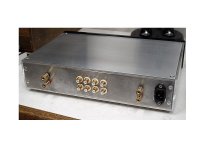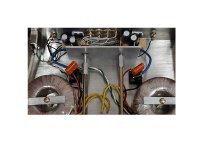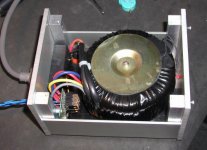Laughing....
I do not think anyone will laugh, I think everyone will praise. I am... great job. May I ask where the chassis came from and what brand of caps did you use beside blackgates?
Guiness
A guiness a day keeps the doctor away
I do not think anyone will laugh, I think everyone will praise. I am... great job. May I ask where the chassis came from and what brand of caps did you use beside blackgates?
Guiness
A guiness a day keeps the doctor away

Very nicely done. So, how it sounds?
You might further improve it by installing discreet drifges with MUR860 diodes. They will cost you less than small BG N type.😉 I don't know exactly how long it takes for them to break in, but I would expect at least 3 weeks. I found those caps nice sounding and not intruding the sonics in any way. What pot are you using?
Try to play with feet. I found that best results are obtained by placing single brass spike in front and two feet in the back made of acrylic with rubber bottom. You can believe it or not, but changing amount and type of rubber under those acrylic feet had great impact on sound. The highs were either muffled or were achieving proper balance and definition.😉
You might further improve it by installing discreet drifges with MUR860 diodes. They will cost you less than small BG N type.😉 I don't know exactly how long it takes for them to break in, but I would expect at least 3 weeks. I found those caps nice sounding and not intruding the sonics in any way. What pot are you using?
Try to play with feet. I found that best results are obtained by placing single brass spike in front and two feet in the back made of acrylic with rubber bottom. You can believe it or not, but changing amount and type of rubber under those acrylic feet had great impact on sound. The highs were either muffled or were achieving proper balance and definition.😉
Re: Laughing....
I second that... 🙂
dave
Guiness said:I do not think anyone will laugh, I think everyone will praise.
I second that... 🙂
dave
Re: Just another integrated Gainclone
BWAAAAAAAHAHAHAHAHAHAHAHAAHAH!!!!!!
Oh. Sorry. Was just reading a story about Michael Jackson hiring a witch doctor to put a curse on Spielberg. 🙂
Great job! Nice clean innards too. Hat's off!
se
Philo said:Laugh if you will, but it makes me happy. 😉.
BWAAAAAAAHAHAHAHAHAHAHAHAAHAH!!!!!!
Oh. Sorry. Was just reading a story about Michael Jackson hiring a witch doctor to put a curse on Spielberg. 🙂
Great job! Nice clean innards too. Hat's off!
se
Peter Daniel said:You might further improve it by installing discreet drifges with MUR860 diodes.
Er, drifges? What the hell are those? They like thingamajigs or whatchamacallits? 🙂
se
gpapag said:Bricolo
At the PSU now, you may start with a series 2R2/5W after the bridge, then 100uF shunt, then a series 2R2/5W, then 1000uF shunt, then a series 2R2/5W, then 2200uF. So you have a 3 step filter, with low charging current spikes at the bridge, and quite low and smooth ripple.
Regards
George
I'm using 0.1uF on the chip, per rail for both pins, and 2200uF in the PSU
did you use the 3 step filter in your PSU? Placing 3 2R2 resistors would lower the supply voltage

Peter Daniel said:I'm using 4.7u BG N right after the bridge in PS and indeed it improves treble, sort of ceans them and adds resolution.
Protos,
I got my OPA 549 samples, in your exerience are they better than LM3875, in other words, are they worth a try?😉
I wouldn't have suggested it to you otherwise.Since you have them there I am sure you are going to give them a try.It will be interesting to see whether you reach the same conclusions.
By the way I was experimenting yesterday with bypass caps again and I found that the polycarbonate 2,2uf give a slightly warmer sound and lift in the midbass.The MKPs were nice but there was apart from a great bass as I said before a little peakiness in treble which I thought was unnecessary.The best combination was the polycarbs with 0,1uf tin and foil paralleled which added a bit of liveliness and midrange openness to the midbassy polycarbs.I have come to the conclusion that playing around with bypass caps is a bit like a very fine tone control where you can tune or voice your amp to your taste/system.
Re: Laughing....
Thanks for the compliments all
The chassis is homemade, even the knobs which are 1.5" 556 silicon bronze. Nice and heavy and add a nice feel to to the volume and switch. Great stuff to work with, by the way. The PSU filter caps are surplus 1000uF/50V Rubycons , the snubbers are Phillips MKT 1uF/400V. Using Mills 10k on the input side. No output resistors. I also have some Caddocks to try but have heard they are dry in a GC. I have some polycarbonate caps and might give protos suggestion a whirl as I prefer a warmer sounding amp.
Peter,
Its sounds great! Smooth, clean and neutral. A bit forward as others have stated. But I knew that from my prototype. It had a little edginess until I put the caps on the bridges, which smoothed it out nicely and the bass tightened up even more. Not sure if the edginess was due to the new BGs or the $14 toroids/$3 bridges I am using. I'll wait and see. I wanted to use BGs on the bridges like you did but only have a couple left and want to use them for another gainclone a friend wants. I will try the discrete MUR860s once the caps break in. The bridges in now are GenSemi out of my prototype with about 100 hours on them. MUCH better sounding than new NTEs I initially built it with. The pot is a $8 carbon 50k log. No balance problems though. The NOS ALPS I bought are indeed balance pots, one is going into an integrated AX I am planning . I am looking at future pot options as well. An easy fix though. The cones are something I will consider for the future as this amp is going to my daughter when my Aleph X is done. What cones are you using, Peter? Are your production models getting them?
While the gainclone sound is some what different than other SS amps I feel I can used my first prototype to test certain components out and get a good feel for their characteristics. Another quick note is about the finish on the metal. It is called BoeShield. It was developed by Boeing for the Shuttle program. It's a liquid spray that is a combination oil, wax and other chemicals. I had it on hand for my saw blades and router bits because it helps prevent burning on hardwoods. Works great on bare metal preventing any oxidation and even better... fingerprints! Gives bare aluminum a slightly darker almost titanium look and evens up the finish. You can get it at woodworking stores.
Thanks for the compliments all

Guiness said:I do not think anyone will laugh, I think everyone will praise. I am... great job. May I ask where the chassis came from and what brand of caps did you use beside blackgates?
Guiness
The chassis is homemade, even the knobs which are 1.5" 556 silicon bronze. Nice and heavy and add a nice feel to to the volume and switch. Great stuff to work with, by the way. The PSU filter caps are surplus 1000uF/50V Rubycons , the snubbers are Phillips MKT 1uF/400V. Using Mills 10k on the input side. No output resistors. I also have some Caddocks to try but have heard they are dry in a GC. I have some polycarbonate caps and might give protos suggestion a whirl as I prefer a warmer sounding amp.
Peter,
Its sounds great! Smooth, clean and neutral. A bit forward as others have stated. But I knew that from my prototype. It had a little edginess until I put the caps on the bridges, which smoothed it out nicely and the bass tightened up even more. Not sure if the edginess was due to the new BGs or the $14 toroids/$3 bridges I am using. I'll wait and see. I wanted to use BGs on the bridges like you did but only have a couple left and want to use them for another gainclone a friend wants. I will try the discrete MUR860s once the caps break in. The bridges in now are GenSemi out of my prototype with about 100 hours on them. MUCH better sounding than new NTEs I initially built it with. The pot is a $8 carbon 50k log. No balance problems though. The NOS ALPS I bought are indeed balance pots, one is going into an integrated AX I am planning . I am looking at future pot options as well. An easy fix though. The cones are something I will consider for the future as this amp is going to my daughter when my Aleph X is done. What cones are you using, Peter? Are your production models getting them?
While the gainclone sound is some what different than other SS amps I feel I can used my first prototype to test certain components out and get a good feel for their characteristics. Another quick note is about the finish on the metal. It is called BoeShield. It was developed by Boeing for the Shuttle program. It's a liquid spray that is a combination oil, wax and other chemicals. I had it on hand for my saw blades and router bits because it helps prevent burning on hardwoods. Works great on bare metal preventing any oxidation and even better... fingerprints! Gives bare aluminum a slightly darker almost titanium look and evens up the finish. You can get it at woodworking stores.
As i cant get the LM3875 as a sample, but i can get the OPA512, OPA541, OPA548 and OPA549 as samples, i will use one of those instead.
Which should i use?
What modifications to this diagram (see fig. 1, Peter Daniels circuit) to make it work with my choise of chip?
Which should i use?
What modifications to this diagram (see fig. 1, Peter Daniels circuit) to make it work with my choise of chip?
Quick question on the caps on the bridges...
I designed my ps very similar to the one suggested by Thorsten below except this configuration is powering both channels. If I wanted to try the cap filter on the bridges would I connect it to the -/+ terminals on the bridges that supply +/- V?
Also what values do you suggest for the cap in this configuration.
I designed my ps very similar to the one suggested by Thorsten below except this configuration is powering both channels. If I wanted to try the cap filter on the bridges would I connect it to the -/+ terminals on the bridges that supply +/- V?
Also what values do you suggest for the cap in this configuration.
An externally hosted image should be here but it was not working when we last tested it.
would a digital multimeter, in frequencymeter mode, be abble to measure at wich frequency a gainclone is oscillating?
by placing the probes on the loudspeaker, the multimeter doesn't detect any frequency
by placing the probes on the loudspeaker, the multimeter doesn't detect any frequency
Bricolo,
I think the noise rejection in those meters would prevent you from seeing the oscillation. Have you tried our suggestions? Particularly moamps' and gpapag's? I think that is where your solution lies.
King 30,
I put the 1uF mylars across +/- DC outputs of the bridges and immediately notice a smoother delivery. Peter is using BG 4,7uF across his discrete rectifiers.
Peter, could you post a pic of your rectifier build? Did you make a PCB for them like your Alephs?
I think the noise rejection in those meters would prevent you from seeing the oscillation. Have you tried our suggestions? Particularly moamps' and gpapag's? I think that is where your solution lies.
King 30,
I put the 1uF mylars across +/- DC outputs of the bridges and immediately notice a smoother delivery. Peter is using BG 4,7uF across his discrete rectifiers.
Peter, could you post a pic of your rectifier build? Did you make a PCB for them like your Alephs?
Bricolo said:would a digital multimeter, in frequencymeter mode, be abble to measure at wich frequency a gainclone is oscillating?
by placing the probes on the loudspeaker, the multimeter doesn't detect any frequency
Hi,
you can detect oscillation with simple multimeter (DC voltage, high Rin) and simple RF probe. BTW, I spoke with a friend about input caps on TDA7294, he also said that input Cap in inverting mode must be inserted (like in king30 pic two post up) if you use input pot. If you connect input directly from source (CD or preamp) with decoupling cap on output, input cap is not necessary.
Regards
Philo said:
Peter, could you post a pic of your rectifier build? Did you make a PCB for them like your Alephs?
This is a pic of a rectifier. I'm currently working on rectifiers for new supplies, but will not bother making PCBs. I'm using protoborads and p2p wiring. When finish, I'll post a pic.
The cones I'm using currently are sourced locally, they are made out of brass and I found them sounding better than some more elaborate spikes. Will postpic later too.
Attachments
Peter Daniel said:This is a pic of a rectifier
Peter,
Have you checked for difference in sonics between the metal washer & bolt, vrs non-magnetic plastic zip-ties to hold the trafo?
dave
Peter Daniel said:That's one thing I didn't check yet 😉. Do you have any opinion on that?
No practical experience yet, but a gut feeling from stuff i picked up when listening in on a conversation between Bill Perkins and Meno van der Veen (latter is Plitron's head of R & D and head honco at Amplio (i think i got that company name right)).
dave
- Status
- Not open for further replies.
- Home
- Amplifiers
- Chip Amps
- This is not just another gainclone


